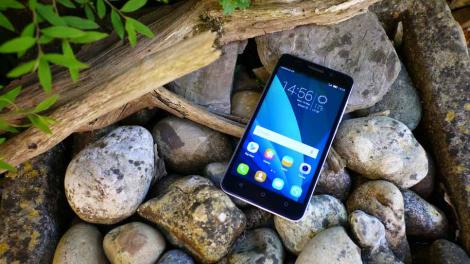
Introduction and design
Huawei’s Honor brand has been churning out some impressive smartphones since its conception in the latter part of 2014. Devices such as the powerful Honor 6 and the super affordable Honor Holly have certainly caused a stir in Western markets, accentuating the rise of Chinese manufacturers.
While much of the recent attention has been focused on the new flagship Honor 6 Plus, the firm’s Honor 4X looks to deliver a similar big-screen experience for those who are a little more budget conscious.
With the exception of the Honor 6 Plus, Honor smartphones are only officially available to purchase online – a sales strategy akin to that used by Xiaomi and OnePlus. The lack of brick-and-mortar stores in particular saves the company vasts amounts of money and partly explains how the firm can offer their smartphones at such competitive prices.
Unlike the aforementioned Chinese duo, Honor do not use inconvenient flash sales or invite systems and sell directly via Amazon UK. The Honor 4X is available for around £150, $245 (roughly AU$295) and when looking at the overall specs on paper, the 4X certainly seems like a real bargain.
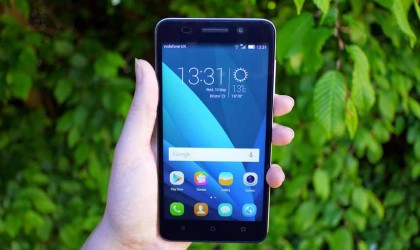
Despite there being plenty of worthy competitors in the same price bracket, such as the Moto G (2014) and Sony Xperia M2 Aqua, there’s currently a chronic shortage of competent budget phablets and this is a void that Honor are looking to fill with the 4X.
Living up to its phablet billing, the Honor 4X features a 5.5-inch 720P display and houses Huawei’s powerful 64-bit Hisilicon Kirin 620 octa-core processor, backed up by 2GB RAM.
Dual-SIM 4G LTE connectivity is also present and the inclusion of both a microSD card slot and a 3000mAh battery will be welcomed by many power users.
While the Honor 4x may not deliver anything exceptional in the looks department, it’s far from an ugly device. The overall build feels incredibly substantial for a budget offering, partly thanks to the 170g worth of heft and textured plastic rear.
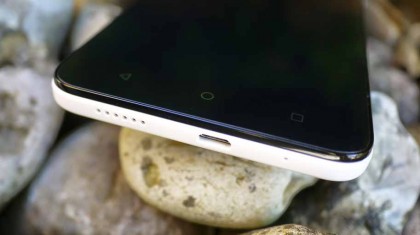
Around the front things are rather restrained, with a recessed black earpiece flanked by proximity and ambient light sensors, an LED notification light and a 5MP front snapper.
Glistening Lollipop-style capacitive navigation keys are present and are certainly the most striking features on the face of the Honor 4X. Unfortunately they’re not backlit and thus you may find yourself fumbling around in the dark trying to hit the correct button from time to time.
The bottom edge, beneath the navigation keys, is home to a slightly off-centre microUSB port, a single microphone and a speaker that is very similar in style to the one found on the iPhone 6.
While a resolution of only 1,280 x 720 doesn’t sound particularly high when stretched across a 5.5-inch screen, the IPS display on the Honor 4X is a strong performer. Colours are vivid with text and images looking fairly crisp.
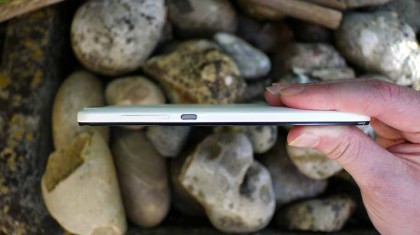
Even with a pixel density of just 267 PPI, individual pixels are not distinctly noticeable when viewing from a normal distance, and viewing angles are excellent. A comprehensive brightness range results in great overall legibility regardless of the lighting conditions, and the auto brightness feature is pleasantly responsive.
Covering the face of the Honor 4X is a factory-applied screen protector, partly to compensate for the lack of Corning Gorilla Glass. Yes, it is a fingerprint magnet, but in everyday use you’ll barely notice it and it’s certainly not a deal-breaker.
The left-hand side of the Honor 4X is completely clean, with the volume rocker and power key both taking up positions on the right edge. Despite the buttons not featuring a metal finish, like those found on flagships such as the HTC One M9 and Samsung Galaxy S6, there’s a decent amount of tactile feedback. They also feel considerably sturdier than the keys on other budget devices such as the Moto G (2014).
Thanks to the aforementioned 75% screen-to-body ratio, hitting the power and volume keys is a straightforward affair. However, reaching the top of the screen, to access the notification bar for example, is a little more of a stretch if your hands are on the smaller side.
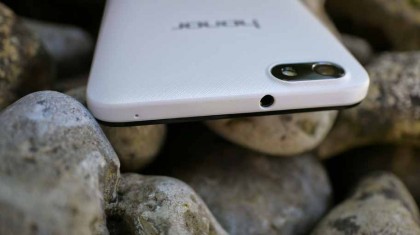
Honor did a great job with the rear of the 4X, making it removable without compromising the overall build quality. The 13MP camera with single LED flash sits flush in the top left, with the Honor branding clearly displayed below.
Much needed grip is provided via the textured rear, and the effect results in a sleeker looking finish than the majority of other budget smartphones.
What impressed me most was the rigidity and quality of the Honor 4X’s removable rear, which exhibits very little flexing or creaking. Unlike the glossy plastic used on the back of the Honor Holly, the rear repels most fingerprints and smudges, keeping the device looking fresh.
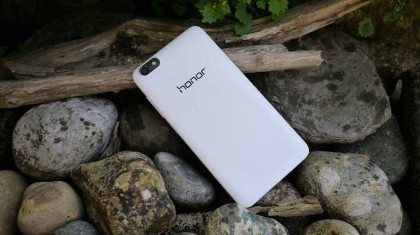
Underneath the removable rear panel you get access to two 4G LTE microSIM slots and a microSD slot. Considering that there’s only 8GB of internal storage I’d highly recommend using a microSD card to expand the storage further, up to the maximum 32GB, if possible.
So far Honor has been pretty reserved in regards to colour options for their devices, with only black or white options available. The 4X follows suit and both colour variants are available for the same price.
Key features and interface
Honor are marketing the 4X as a high-spec smartphone with an affordable price tag, highlighting compelling hardware and software features.
Power is arguably one of the biggest draws of the Honor 4X, with the Chinese manufacturer claiming it to be the most powerful budget smartphone currently available thanks to the inclusion of a Kirin 620 octa-core processor and 2GB RAM.
Honor also emphasises the longevity of the 4X’s 3000mAh battery, along with the optical performance of both the 13MP primary snapper and 5MP front-facing shooter. Sit tight, as all of these features are covered in depth later on in the performance, battery life and camera sections of the review.
Outside of Asia and other developing markets, the inclusion of dual-SIM functionality in affordable smartphones seems to be slowly on the rise. Like the recently released Acer Liquid Jade S and ZTE Blade S6, the Honor 4X looks to appeal to a niche group of users who normally have to carry around separate work and personal phones.
Frequent international travellers and business people in particular will appreciate the ability to use two microSIM cards in the Honor 4X, reducing the need to hot-swap between a local and foreign SIM card every few days.
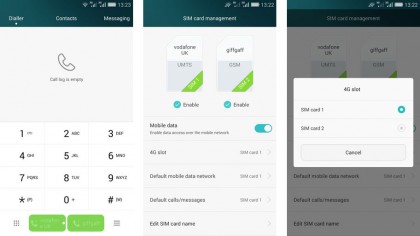
In addition, both microSIM cards in the Honor 4X can access 4G LTE frequencies which is rare for a smartphone outside of China. Most competing dual-SIM devices in the same price bracket only offer 4G LTE connectivity on a single SIM, such as the Moto G (2014), making the 4X a must-have for high-speed data fanatics.
Huawei’s custom Emotion UI (EMUI) 3.0 is present on the Honor 4X and runs on top of Android 4.4.2 KitKat. While not the latest version of Google’s OS, KitKat is a stable option until the major bugs in Lollipop are squashed. Honor has promised regular software updates for the 4X, and users should expect to see Android 5.0 on their devices in the next couple of months.
Many of the big name Android smartphone manufacturers, such as Samsung and LG, have been refining their custom user interfaces to adhere more to Google’s material design guidelines. Yet the majority of Chinese firms are sticking to their principles, continuing to opt for a heavily tweaked experience that aesthetically tends to resemble iOS rather than Android.
Like Xiaomi’s MIUI and Meizu’s Flyme OS, Emotion UI on Huawei and Honor devices aims to offer a simpler, more customisable experience than (near) stock Android. In practice it does add some useful features, but arguably at the expense of a visually appealing design. Android purists will be having nightmares about the garish, cartoon-like icons and overall lack of theme cohesiveness throughout Emotion UI 3.0 on the Honor 4X.
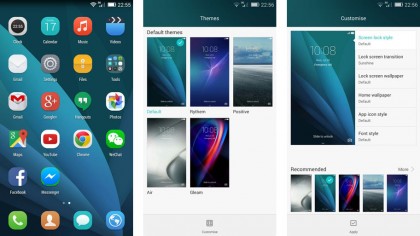
While having apps spread across multiple homescreens maybe less confusing for some users, I personally found it too cluttered. In order to make enough room for widgets, without having a multitude of homescreens, you’ll have to resort to cramming apps into folders.
Thankfully there’s very little bloatware on the Honor 4X, so you’ll never need an iOS-style unused apps folder. That being said, the pre-loaded Mirror and Magnifier apps will not be particularly useful to most and just seem to be rather gimmicky extensions of the camera software.
Google apps are welcome additions however, with all the basics such as Play Store, Gmail, Maps and Chrome running smoothly. The only issue I found was that the icons for these and other third-party apps were inconsistent and looked out of place when compared to the stock EMUI apps.
This minor gripe can be overcome on the Honor 6 with the theme app, which allows you to download online themes. On my Honor 4X review unit the theme app only displayed five default themes, without giving me access to more online content. The Indian retail version of the 4X can access online themes, so expect to see that feature available now (or in the near future) on other countries’ variants.
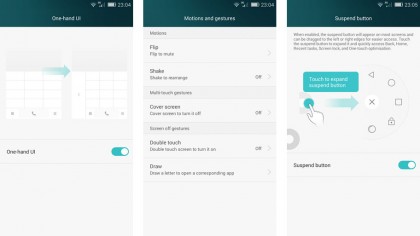
Motion control and smart assistance settings are very handy additions to Emotion UI, especially considering the Honor 4X’s large footprint. Screen-off gestures such as double touch to wake and the ability to draw certain letters on the screen to launch corresponding apps are functional, if not game changing.
Reaching across a phablet screen one-handed can often be a challenge for those with smaller hands, so Emotion UI has introduced a few features to make using the Honor 4X a little less of a chore. One-hand UI acts much like the one-handed Input mode on the Samsung Galaxy Note 4, moving the dialler pad and keyboard to your preferred side of the screen.
A feature called suspend button can also be enabled, allowing the user to access the back, home, recent tasks, screen lock and optimisation soft keys from either edge of the Honor 4X’s screen. It doesn’t sound like a big deal, but during everyday use I found this feature pretty helpful, meaning that I didn’t have to reach down to reach the capacitive buttons.
Like the Huawei Ascend Mate 7, Honor 6 and Liquid Jade S, the Honor 4X includes DTS enhanced audio. You have to enable the feature within the sound settings menu, and while it does improve sound quality through headphones, output through the speaker is still mediocre.
Performance and battery life
Most budget smartphones suffer from sluggish overall performance, especially when it comes to multitasking and playing graphically intensive games.
Powerful performance is one of the Honor 4X’s most touted features, with the Chinese firm managing to pack in an impressive 64-bit Kirin 620 octa-core processor, 2GB RAM and Mali-450 GPU. In comparison to flagships such as the Nexus 6 and Samsung Galaxy S6 Edge these specs may seem rather tame, but for an affordable smartphone they are superb.
Benchmarking results backed up the relatively high specs, with the Honor 4X scoring an average of 1,705 on the Geekbench 3 multi-core test. That trounces results recorded by similarly priced phones such as Moto G (2014) (1,142) and Sony Xperia M2 Aqua (1,133). Even some of the cheaper mid-range devices like the Huawei Ascend G7 (1,398) fall to the might of the Honor 4X.
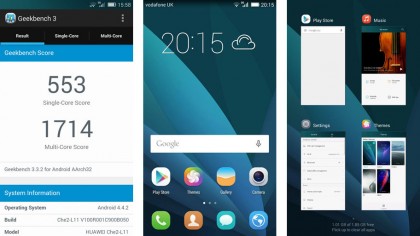
At times during everyday use you forget that the Honor 4X is an affordable smartphone. Navigating through the Emotion UI is a smooth and snappy experience, app loading times are fair and multitasking is handled competently thanks to the 2GB RAM.
Currently the Honor 4X comes loaded with 4.4.2 KitKat, which does not take full advantage of the 64-bit Kirin 620 processor. Google’s latest Android version is optimised for 64-bit architecture and thus with an Android Lollipop update just around the corner, the Honor 4X has the potential to provide even greater performance.
Those looking to enjoy a large number of graphically intensive games on the Honor 4X’s 5.5-inch display will probably be disappointed. Titles like Temple Run 2 and Sonic Dash run pretty smoothly and more demanding games such as Real Racing 3 are playable – just be prepared for a few dropped frames.
The main killer here is the lack of internal storage, with only around half of the supplied 8GB available to the user. A further 32GB can be added via a microSD card, but heavy gamers should probably put that extra cash towards a more graphically-capable device.
Battery life
Behind the removable back panel of the Honor 4X lies a hefty non-removable 3000mAh battery. In terms of sheer capacity that’s a tad bigger than the 2915mAh unit found in the iPhone 6 Plus and significantly larger than the HTC Desire 820’s 2,600mAh power pack.
Both of these examples pack more powerful processors than the Honor 4X, and many high-end phablets, such as the LG G3, also include higher resolution panels. Therefore on paper, the Honor 4X’s large capacity battery combined with a low resolution screen and less power-hungry processor should result in great battery life.
On the whole, the battery performance of the Honor 4X was stellar. I found it extremely difficult to drain the battery completely in just one day, and even the heaviest of users will still probably end the day without encountering the much maligned low juice warning.

While power users may still need to put the Honor 4X on charge overnight, the vast majority of people (light-to-moderate users) won’t need to plug in until later on the following day. Two day battery life is definitely achievable, especially for users who dip into the ‘Smart’ and ‘Ultra’ power saving modes built into Emotion UI 3.0.
Those who intend to make use of the Honor 4X’s dual-SIM functionality will see their battery life suffer accordingly. However the difference is pretty negligible and not enough to hamper the tremendous longevity of the Honor 4X’s battery.
After running the TechRadar test video at full brightness and volume for 90 minutes, the battery level of the Honor 4X only dropped by 22%. That’s only 3% worse than the monumental Samsung Galaxy Note 4 and 5% better than the much revered iPhone 6 Plus.
Things also look impressive when comparing the Honor 4X’s test result to that of a 720P smartphone with similar specs. The Honor 4X manages to attain roughly the same result as its relative, the Huawei Ascend G7. Both use the same 720P display and 3000mAh battery, yet the Honor 4X packs a more powerful Kirin 620 processor as opposed to a Snapdragon 410.
The aforementioned Lollipop update could yet improve the Honor 4X’s battery life even further, with 64-bit optimisation reducing overall power consumption. Now there’s a thought.
The essentials and camera
The essentials
Despite the budget price tag and inclusion of numerous sophisticated hardware and software features, the Honor 4X does not skimp on the essentials.
Holding the hefty 4X up to your ear is far less of a chore than you’d expect and the overall call experience is rather pleasant. The earpiece delivers a loud, crisp sound and the secondary microphone up top does a good job of cutting out background noise. The primary microphone also performs well, with those on the other end of the line stating that my voice sounded clear and perfectly audible.
The bottom mounted speaker on the Honor 4X may not look like much, but it sure does pack a punch. An extremely loud output means that you’ll rarely miss a call or notification, even if the speaker is partly muffled.
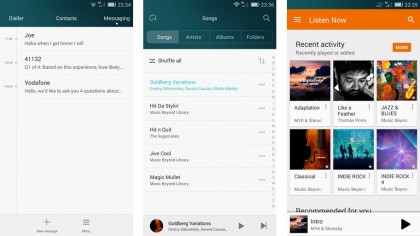
Questionable aesthetics aside, Emotion UI 3.0 conveys the core smartphone features simply and effectively. The ‘Dialler’, ‘Contacts’ and ‘Messaging’ apps are all integrated, so no matter which app you choose to open from the homescreen, you’re only just a swipe away from the other two.
A few of the pre-installed Google apps such as ‘Photos’, ‘Chrome’ and ‘Hangouts’ offer more feature-full and ecosystem-integrated alternatives than their stock Emotion UI counterparts. Although most users will find Honor’s stock apps to be perfectly adequate for undertaking simple tasks, these extra options may cause unnecessarily confusion.
The three different keyboard apps included on the Honor 4X could also bamboozle first-time smartphone users. On this occasion I feel that the default Huawei Swype keyboard does a better job than the pre-loaded AOSP and Google alternatives. Keys are large, well spaced, and the autocorrect function is pretty intuitive.
As a result, typing on the Honor 4X was a fluid and relatively error free experience. Swapping between multiple languages is as easy as holding down the space key, and the keyboard theme compliments Emotion UI 3.0 well.
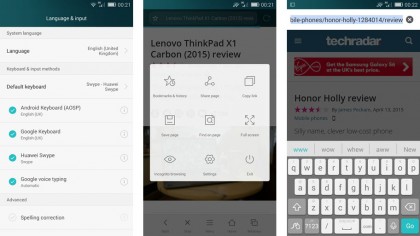
Web browsing on the Honor 4X’s stock browser or Google Chrome was smooth and snappy using mobile data and WIFI, partly thanks to the decent processing power available. Overall, Chrome was the swifter of the two, yet I really enjoyed using the full screen function of the stock browser when reading online articles.
If you consume a lot of media on your smartphone, then the Honor 4X has you covered. The combination of a large 5.5-inch display, powerful speaker and high-capacity battery result in a portable, media-centric device that will provide you with hours of entertainment.
Though the Honor 4X’s speaker’s output is loud, it does lack quality. Thus audiophiles will probably want to use a pair of headphones and turn on DTS sound enhancement in the settings in order to obtain decent audio quality.
Camera
If packing a powerful processor, dual-SIM functionality and huge battery into the Honor 4X wasn’t enough already, the breakaway brand have managed to cram in a 13-megapixel shooter with single LED flash and a 5MP front-facing snapper.
The high mega-pixel count certainly doesn’t tell the whole story but considering the low price of the Honor 4X, the primary camera performs remarkably well.

Out of the box, the resolution of the Honor 4X’s camera defaults to just 10MP, in order to use a 16:9 aspect ratio. If you want bump up the resolution to the full 13MP you’ll have to put up with a boxier 4:3 aspect ratio and the resultant black bar at the base of the viewfinder.
In general I found the camera software on the Honor 4X fairly polished and easy to navigate. Instead of stripping away features from the budget friendly 4X’s Emotion UI camera app, Honor has retained the options found in more premium devices such as the Honor 6 and Huawei Ascend Mate 7.
While there aren’t as many tweakable shooting modes and options as on the Sony Xperia Z3, the Honor 4X’s camera software is far more feature-full than the Motorola camera app on the wallet-friendly Moto E (2015).
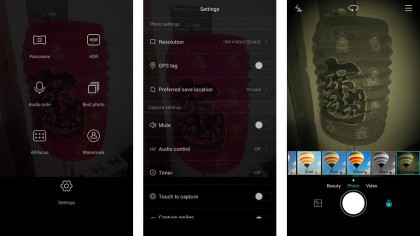
The usual HDR, panorama and video modes are all present, as well as an array of filters and some rather tacky shooting modes like beauty and watermark. I personally like the concept of the all focus mode, allowing the user to re-position the focal point of the image after the shot has been taken. However the feature’s implementation is a little clunky and you’ll have to decide whether you want to refocus an image or not before actually taking it.
Diving into the camera settings menu pulls up a long list of photo and capture options. Here you can alter the photo resolution and, unlike the Google camera app, select your preferred save location.
The audio control feature can be also be enabled from the settings menu and while it sounds promising on paper, functionality is very limited. Only three words, two of which are Chinese, can be used to trigger the shutter button, and the ability to take a photo when your voice reaches a certain decibel level often leads to numerous unintentional snaps.
Hopefully future updates to Emotion UI will include useful additions to the feature. I’d personally like to see an option to switch between different shooting modes and capture settings using voice, as this handy function works extremely well on the Acer Liquid Jade S.
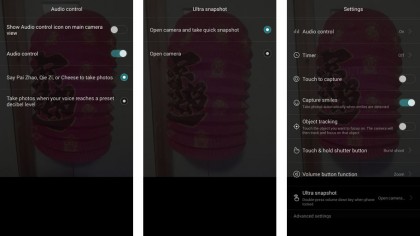
Auto-focus speeds are acceptable and tap to focus also displays a slider, allowing you to easily adjust white balance levels. If you need to get a shot off in a hurry, the Honor 4X’s ultra snapshot setting has got you covered. Double tapping the volume down key on the side of the 4X while the screen is off launches the camera and takes a snap. Despite results not always being in focus, the whole process only takes just over a second and this function could save you those all important seconds when trying to snap that crucial shot.
If the Honor 4X was a mid-range smartphone, camera results would probably be deemed pleasant or satisfying, rather than anything particularly noteworthy. Yet when taking into account the affordable price of just £150 (roughly $235, AU$295), image quality is quite remarkable.
Images taken in good light are sufficiently detailed and the Honor 4X does well to capture vibrant, natural-looking colours without completely over-saturating the results. Exposure is good for the most part, but colours can be washed-out in extremely bright conditions. A little background noise is present when zooming in a fair distance, but unless you’re looking to do some serious cropping it’s not terribly noticeable.
While the camera software on the Honor 4X does not have a dedicated macro mode, close-up shots are excellent. A fair amount of detail is retained, even on the smallest of subjects, colours are vivid once again, and a shallow depth of field makes for a pleasantly blurred background.
In low light scenarios the Honor 4X’s camera does start to struggle. HDR mode is available, but it fails to significantly improve results. Detail is retained reasonably well when using a high ISO value, partly thanks to the f/2.0 lens, yet images are still a little grainy.
1080P video recording, at 30 frames per second, is available via the Honor 4X’s 13MP primary camera, and the quality is respectable. Changes in exposure are somewhat harsh, nevertheless for a budget device I was more than satisfied with the rear snapper’s video recording capabilities.
The 5MP front-facing shooter on the Honor 4X is easily a cut above the 2MP units found on the Moto G (2014)and Honor Holly. Crisp selfies and the ability to record 720P video will please the majority of social media fanatics.
Sample images

Click here for the full-res image

Click here for the full-res image

Click here for the full-res image
Verdict
The Honor 4X represents fantastic value for money, offering a powerful big screen experience and a multitude of advanced features for a low price.
We liked
Honor promised power on a budget and they delivered. While the 4X is no match for high-end flagships, it performs significantly better than the current crop of cheap smartphones. There’s none of the usual budget-associated lag or stutter while navigating through Emotion UI 3.0, and the generous 2GB of RAM makes for swift multitasking.
Battery life is another area where the Honor 4X excels, with the 3000mAh power pack providing between one and two day’s worth of juice, depending on usage.
Despite the battery being of the non-removable variety, lifting off the rear panel is necessary in order to access the 4G dual-SIM and microSD card slots. Both additions are extremely welcome and well implemented, although the former may only appeal to a niche group of users.
Affordable handsets often suffer from poor build quality, particularly those with removable rear panels like the Honor 4X. Yet the 4X feels extremely well made, with the body showing no signs of major flexing or creaking, and the buttons giving off some nice tactile feedback.
The 13MP rear camera and the 5MP snapper up front out-perform the units found on most affordable smartphones, and the Honor 4X can even take better snaps than some mid-rangers when in well-lit environments.
We disliked
Emotion UI 3.0 on the Honor 4X is certainly an improvement over previous iterations, yet it still has some critics. The almost cartoon-like aesthetics are not to everyone’s tastes, and while the lack of an app drawer may make things simpler for first time Android users, it can also result in rather cluttered homescreens.
Honor has had to make some cuts in order to keep the price of the 4X down, and unfortunately that means no Coring Gorilla Glass screen protection. A factory-applied screen protector is present to help protect the glass underneath from scratching, but it does attract a lot of fingerprints.
To cut costs further, Honor has not included a backlight for the capacitive keys below the screen, and thus trying to hit the correct key in the dark can sometimes be a bit of a challenge.
Among the plethora of smartphones currently available, the design of the Honor 4X may not help it stand out, and for some the aesthetics will seem too minimal.
The fact that it’s only available SIM-free via Amazon may also deter those who are accustomed to subsidised contracts and potential buyers who prefer to test out smartphones in-store before purchasing.
Verdict
Honor has once again delivered a very capable smartphone that embodies the company’s value for money ethos. The breakaway brand’s rapid rise to prominence is exciting for consumers and a major headache for other manufacturers.
Motorola maybe the king of budget smartphones for the time being but with the 4X, Honor is clearly signalling that it’s ready to go toe-to-toe with the Lenovo-owned brand in the affordable segment of the market.
In the majority of areas the Honor 4X performs significantly better than rival budget devices, combining excellent performance and a multitude of features with impressive build quality.
If you can live with the large form-factor and highly customised Emotion UI, the Honor 4X may well be the budget smartphone you’re looking for.
First reviewed: May 2015
![]()
Related Posts
December 6, 2021
7+ Web Design Trends for 2022: Which Will You Use?
December 6, 2021
The 10 Best WordPress Booking Plugins to Use On Your Website
December 6, 2021
How to Use a Web Cache Viewer to View a Cached Page
November 6, 2021
10 Modern Web Design Trends for 2022
November 6, 2021
Best Free SSL Certificate Providers (+ How to Get Started)
November 6, 2021
How to Design a Landing Page That Sends Conversions Skyrocketing
November 6, 2021
What Are the Best WordPress Security Plugins for your Website?
October 6, 2021
Your Guide to How to Buy a Domain Name
October 6, 2021
How to Build a WordPress Website: 9 Steps to Build Your Site
September 6, 2021
10 Best Websites for Downloading Free PSD Files
September 6, 2021
HTML5 Template: A Basic Code Template to Start Your Next Project
September 6, 2021
How Much Does It Cost to Build a Website for a Small Business?
September 6, 2021
A List of Free Public CDNs for Web Developers
September 6, 2021
6 Advanced JavaScript Concepts You Should Know
August 6, 2021
10 Simple Tips for Launching a Website
August 6, 2021
25 Beautiful Examples of “Coming Soon” Pages
August 6, 2021
10 Useful Responsive Design Testing Tools
August 6, 2021
Best-Converting Shopify Themes: 4 Best Shopify Themes
July 6, 2021
What Is Alt Text and Why Should You Use It?
July 6, 2021
24 Must-Know Graphic Design Terms
June 6, 2021
How to Design a Product Page: 6 Pro Design Tips
April 6, 2021
A Beginner’s Guide to Competitor Website Analysis
April 6, 2021
6 BigCommerce Design Tips For Big Ecommerce Results
April 6, 2021
Is WordPress Good for Ecommerce? [Pros and Cons]
March 6, 2021
Make Websites Mobile-Friendly: 5 Astounding Tips
March 6, 2021
Shopify vs. Magento: Which Platform Should I Use?
March 6, 2021
Top 5 Web Design Tools & Software Applications
February 6, 2021
Website Optimization Checklist: Your Go-To Guide to SEO
February 6, 2021
5 UX Design Trends to Dazzle Users in 2021
February 6, 2021
What Is the Average Page Load Time and How Can You Do Better?
February 6, 2021
Choosing an Ecommerce Platform That Will Wow Customers
February 6, 2021
7 Best Practices for Crafting Landing Pages with Forms
February 6, 2021
7 B2B Web Design Tips to Craft an Eye-Catching Website
January 6, 2021
Mobile-Friendly Checker | Check Your Site’s Mobile Score Now
January 6, 2021
8 Tips for Developing a Fantastic Mobile-Friendly Website
December 6, 2020
How to Add an Online Store to Your Website [4 Ways]
December 6, 2020
5 UX Design Tips for Seamless Online Shopping
November 6, 2020
Ecommerce Website Essentials: Does Your Site Have All 11?
November 6, 2020
5 Small Business Website Essentials You Need for Your Site
November 6, 2020
Your Website Redesign Checklist for 2020: 7 Steps for Success
May 1, 2020
Psychology of Color [Infographic]
April 21, 2020
How to start an online store that drives huge sales
January 3, 2020
5 Lead Generation Website Design Best Practices
March 6, 2019
6 Reasons You Should Redesign Your Website in 2019
March 6, 2019
7 Web Design Trends for 2019
February 19, 2019
Who owns the website/app source code, client or developer
February 7, 2019
Don’t Let Your Domain Names Expire in 2019
January 8, 2019
2019 Website Development Trends To Note
October 6, 2017
How Web Design Impacts Content Marketing
October 6, 2017
How to Choose a Navigation Setup
August 6, 2017
Why User Experience Matters to Marketing
July 6, 2017
5 Ways Web Design Impacts Customer Experience
September 6, 2016
How to Learn Angular
September 6, 2016
The Excuses for Not Having a Website (Infographic)
September 6, 2016
How to Build an Award-Winning Web Design Team
September 6, 2016
13 Free Data Visualization Tools
August 6, 2016
How Selling Pastries Helped Us Design a Better Product
August 6, 2016
11 Sites to Help You Find Material Design Inspiration
July 4, 2016
How to change free wordpress.com url
April 6, 2016
The 5 Best Free FTP Clients
April 6, 2016
7 Free UX E-Books Worth Reading
March 6, 2016
Can Handwritten Letters Get You More Clients?
December 10, 2015
Star Wars Week: How to create your own Star Wars effects for free
December 6, 2015
20 "Coming Soon" Pages for Inspiration
December 6, 2015
6 Free Tools for Creating Your Own Icon Font
December 6, 2015
9 Useful Tools for Creating Material Design Color Palettes
November 6, 2015
20 Free UI Kits to Download
November 6, 2015
50 Web Designs with Awesome Typography
November 6, 2015
When to Use rel="nofollow"
November 6, 2015
7 Free Books That Will Help You Become More Productive
November 6, 2015
50 Beautiful One-Page Websites for Inspiration
November 6, 2015
Circular Images with CSS
October 6, 2015
Lessons Learned from an Unsuccessful Kickstarter
October 6, 2015
5 Games That Teach You How to Code
October 6, 2015
Cheatsheet: Photoshop Keyboard Shortcuts
October 6, 2015
An Easy Way to Create a Freelance Contract for Your Projects
October 6, 2015
50 Design Agency Websites for Inspiration
September 29, 2015
JB Hi-Fi shutting the book on ebooks
September 24, 2015
Opinion: Quick, Quickflix: It's time to give yourself the flick
September 24, 2015
New Star Wars 360-degree video is among first on Facebook
September 21, 2015
Apple purges malicious iPhone and iPad apps from App Store
September 12, 2015
Apple's new Live Photos feature will eat up your storage
September 12, 2015
The latest Windows 10 Mobile preview has been delayed
September 12, 2015
IBM buys StrongLoop to add Node.js development to its cloud
September 8, 2015
Fake Android porn app takes your photo, then holds it ransom
September 6, 2015
50 Restaurant Websites for Inspiration
September 6, 2015
Zero UI — The Future of Interfaces
September 6, 2015
50 Beautiful Websites with Big Background Images
September 6, 2015
Infographic: 69 Web Design Tips
September 6, 2015
Free Windows 10 Icons
September 2, 2015
Instagram turns itself into a genuine messaging service
August 11, 2015
In Depth: How Microsoft taught Cortana to be more human
August 11, 2015
Windows 10 price, news and features
August 11, 2015
Windows 10's broken update introduces endless reboot loop
August 11, 2015
Windows 10 races to 27m installs
August 11, 2015
Windows 10 IoT Core gets first public release
August 10, 2015
iOS Tips: How to backup iPhone to an external drive
August 10, 2015
Windows 8.1 RT finally getting Windows 10 Start Menu
August 10, 2015
How to use Windows Hello
August 10, 2015
Review: Moto Surround
August 10, 2015
Review: Moto G (2015)
August 9, 2015
8 of the best free VPN services
August 8, 2015
Use Firefox? Mozilla urges you update ASAP
August 7, 2015
Mac Tips: Apple Mail: How to remove the Favorites Bar
August 7, 2015
How to make the OS X dock appear faster
August 7, 2015
Review: BQ Aquaris E45 Ubuntu Edition
August 7, 2015
Review: Acer Liquid Jade Z
August 6, 2015
How to reinstall Linux
August 6, 2015
How to reinstall Windows
August 6, 2015
Updated: Apple Music: release date, price and features
August 6, 2015
Social News Websites for Front-End Developers
August 6, 2015
10 Free JavaScript Books
August 6, 2015
50 Beautiful Blog Designs
August 6, 2015
Animated SVG Pipes Effect
August 6, 2015
Launching Your First App
August 5, 2015
Windows 10 goes freemium with paid apps
August 5, 2015
Updated: Week 1 with Windows 10
August 5, 2015
Mac Tips: How to manage Safari notifications on Mac
August 5, 2015
Microsoft Sway may kill the PowerPoint presentation
August 4, 2015
Microsoft gives Outlook on the web a new look
August 4, 2015
Mac OS X vulnerable to new zero-day attack
August 4, 2015
Windows 10 users warned of two scams
August 4, 2015
Microsoft's Docs.com is now available to everyone
August 3, 2015
Mac Tips: How to edit the Favorites sidebar on Mac
August 3, 2015
Updated: Windows 10 price, news and features
July 29, 2015
Review: HP ProDesk 405 G2
July 29, 2015
Hands-on review: HP Elite x2 1011
July 29, 2015
Hands-on review: Updated: Windows 10 Mobile
July 29, 2015
Review: Updated: Nvidia Shield Android TV
July 28, 2015
LIVE: Windows 10 launch: Live Blog!
July 28, 2015
How to prepare for your upgrade to Windows 10
July 28, 2015
Review: Updated: Windows 10
July 28, 2015
Review: Updated: HP Pro Tablet 608
July 28, 2015
Review: Heat Genius
July 28, 2015
Hands-on review: Moto X Play
July 28, 2015
Hands-on review: Moto X Style
July 28, 2015
Hands-on review: Moto G (2015)
July 28, 2015
Review: 13-inch MacBook Air (early 2015)
July 28, 2015
Hands-on review: OnePlus 2
July 28, 2015
Review: LG 65EG960T 4K OLED
July 28, 2015
Mac Tips: How to share printers on Mac
July 27, 2015
Apple Music's arrival hasn't opened Pandora's box
July 26, 2015
Review: Garmin Swim
July 25, 2015
How to merge OS X contacts into an existing list
July 25, 2015
Hands-on review: UPDATED: ZTE Axon
July 24, 2015
Mac Tips: How to zoom in on a Mac
July 24, 2015
What Windows 10 means for the enterprise
July 24, 2015
Review: JBL Charge 2 Plus
July 24, 2015
Review: Acer Aspire S7
July 24, 2015
Review: Updated: Canon G3 X
July 24, 2015
Review: Updated: iPad Air 2
July 24, 2015
Review: Thinksound On1
July 24, 2015
Review: Asus Chromebook Flip
July 24, 2015
Review: Garmin Forerunner 225
July 23, 2015
Review: Garmin nuvi 68LM
July 23, 2015
Review: Samsung Galaxy S6 Active
July 23, 2015
Review: Bowers and Wilkins P5 Wireless
July 23, 2015
Review: Dell XPS 15 (2015)
July 21, 2015
Review: Fuji S9900W
July 21, 2015
Review: Updated: Fitbit Surge
July 21, 2015
Review: UE Roll
July 21, 2015
Hands-on review: Ubik Uno
July 20, 2015
Review: Samsung HW-J650
July 20, 2015
Updated: 40 best Android Wear smartwatch apps 2015
July 20, 2015
Review: Acer Chromebook C740 review
July 20, 2015
Review: Huawei Talkband B2
July 20, 2015
Review: Dell Venue 10 7000
July 20, 2015
Review: Intel Core i7-5775C
July 17, 2015
Mac Tips: How to delete locked files on Mac
July 17, 2015
Review: Pebble Time
July 16, 2015
Microsoft just made Windows XP even less secure
July 16, 2015
Windows 8.1 RT is getting an update this September
July 16, 2015
OS showdown: Windows 10 vs Windows 8.1 vs Windows 7
July 16, 2015
Review: Acer CB280HK
July 15, 2015
Windows 10 is ready for new laptops and PCs
July 15, 2015
Explained: How to take a screenshot in Windows
July 15, 2015
Office for Windows 10 appears in latest build
July 14, 2015
Review: ZTE Axon
July 14, 2015
Review: ViewSonic VP2780-4K
July 14, 2015
Hands-on review: SanDisk Connect Wireless Stick
July 14, 2015
Review: Oppo PM-3
July 14, 2015
Review: BT 11ac Dual-Band Wi-Fi Extender 1200
July 14, 2015
Review: Fuji X-T10
July 13, 2015
How to build an SEO strategy for your business
July 13, 2015
Review: Lenovo ThinkPad Yoga 15
July 13, 2015
Review: Audio-Technica ATH-MSR7
July 13, 2015
Review: Garmin NuviCam LMT-D
July 13, 2015
Review: Dell Inspiron 13 7000
July 13, 2015
Hands-on review: AstroPi SenseHAT
July 13, 2015
Hands-on review: EE Rook
July 13, 2015
Hands-on review: Updated: HTC Vive
July 12, 2015
Here's the ultimate software list for PC fanatics
July 10, 2015
How to use the new Photos app for Mac
July 10, 2015
Windows 10 Insider Preview Build 10166 available now
July 10, 2015
Splunk spends big on cybersecurity acquisition
July 10, 2015
Making Windows 10 apps just got a whole lot easier
July 10, 2015
Review: Lenovo LaVie Z 360
July 9, 2015
OS X El Capitan public beta available right now
July 9, 2015
Microsoft finally unveils Office 2016 for Mac
July 9, 2015
Review: Updated: Chromecast
July 9, 2015
Review: Updated: Tesco Hudl 2
July 9, 2015
Review: Lenovo ThinkPad E550
July 9, 2015
Review: Updated: Google Nexus 6
July 8, 2015
What you need to know about Windows Server 2016
July 7, 2015
Microsoft to hike enterprise cloud pricing
July 6, 2015
Hacking Team end up being totally 0wned
July 6, 2015
Review: HP Pro Slate 12
July 6, 2015
Review: Samsung 850 Pro 2TB
July 6, 2015
Review: Asus RT-AC87U
July 6, 2015
Review: Jawbone UP2
July 6, 2015
Reimagining the Web Design Process
July 6, 2015
50 Clean Websites for Inspiration
July 6, 2015
15 Free Books for People Who Code
July 6, 2015
Web Storage: A Primer
July 6, 2015
A Look at Some CSS Methodologies
July 3, 2015
6 Essential Mac Mouse and Trackpad Tips
July 2, 2015
How to install a third party keyboard on Android
July 2, 2015
Review: UPDATED: Asus Zenfone 2
July 2, 2015
Review: Alienware 13
July 2, 2015
Review: HP DeskJet 1010
July 1, 2015
5 issues we want Apple Music to fix
June 13, 2015
Cortana will get its own button on Windows 10 PCs
June 12, 2015
Windows 10 will come with universal Skype app
June 12, 2015
iPad music production: 18 Best apps and gear
June 12, 2015
Windows 10 all set for early enterprise struggle
June 12, 2015
Review: Garmin VIRB Elite
June 11, 2015
Review: Updated: Nvidia Shield Tablet
June 11, 2015
Review: Nokia Lumia 635
June 10, 2015
Microsoft brings more online tweaks to Office 365
June 10, 2015
Mac Tips: How to use Screen Sharing in Mac OS X
June 9, 2015
Hands-on review: Meizu M2 Note
June 9, 2015
Hands-on review: EE 4GEE Action Camera
June 9, 2015
Review: Toshiba 3TB Canvio external hard drive
June 9, 2015
Review: Olympus SH-2
June 8, 2015
Hands-on review: Updated: Apple CarPlay
June 8, 2015
UPDATED: iOS 9 release date, features and news
June 8, 2015
Review: Updated: Roku 2
June 8, 2015
Review: Updated: PlayStation Vue
June 8, 2015
Review: Dell PowerEdge R730
June 8, 2015
Review: Canon SX710 HS
June 7, 2015
UPDATED: iOS 9 release date, features and rumors
June 7, 2015
Review: Lenovo S20-30
June 6, 2015
Free Writing Icons
June 6, 2015
15 CSS Questions to Test Your Knowledge
June 6, 2015
The Best CSS Reset Stylesheets
June 6, 2015
How CSS Specificity Works
June 5, 2015
'Delay' is a new feature in Windows 10
June 5, 2015
Review: Beyerdynamic Custom One Pro Plus
June 5, 2015
Latest SEO Marketing tools
June 5, 2015
Review: Nvidia Shield Android TV
June 5, 2015
Review: In Depth: Oppo R5
June 3, 2015
Hands-on review: Huawei P8 Lite
June 3, 2015
How To: How to create eBooks on a Mac
June 3, 2015
Review: Updated: Tidal
June 3, 2015
Review: Canon 750D (Rebel T6i)
June 2, 2015
Review: Updated: Asus ZenWatch
June 2, 2015
Review: Alcatel OneTouch Idol 3
June 2, 2015
Review: Updated: Nokia Lumia 1520
June 2, 2015
Review: Updated: Yotaphone 2
June 2, 2015
Review: Updated: Nokia Lumia 625
June 2, 2015
Review: Creative Muvo Mini
June 1, 2015
Review: Acer TravelMate P645 (2015)
June 1, 2015
Hands-on review: Corsair Bulldog
May 29, 2015
In Depth: NetApp: a requiem
May 29, 2015
July is looking definite for Windows 10 release
May 29, 2015
Hands-on review: Google Photos
May 28, 2015
Mac Tips: The 16 best free GarageBand plugins
May 28, 2015
Review: Canon 760D (Rebel T6s)
May 27, 2015
Review: Lenovo Yoga 3 14
May 27, 2015
Hands-on review: Serif Affinity Photo
May 27, 2015
Review: Garmin Vivoactive
May 26, 2015
Review: Datacolor Spyder5 Elite
May 26, 2015
Hands-on review: Sony Xperia Z3+
May 26, 2015
Review: Epson BrightLink Pro 1410Wi
May 26, 2015
Review: Technics Premium C700
May 26, 2015
Review: Canon EOS M3
May 26, 2015
Review: Updated: HTC One M9
May 26, 2015
Review: Updated: Sony Xperia Z3 Compact
May 25, 2015
Review: Updated: New Nintendo 3DS
May 25, 2015
Updated: 50 best Mac tips, tricks and timesavers
May 25, 2015
Updated: Windows email: 5 best free clients
May 25, 2015
Instagram is planning to invade your inbox
May 25, 2015
Review: Updated: Foxtel Play
May 24, 2015
How Windows 10 will change smartphones forever
May 24, 2015
Review: Vodafone Smart Prime 6
May 24, 2015
Review: Updated: iPad mini
May 22, 2015
Office Now may be Cortana for your work life
May 22, 2015
Review: Updated: Lenovo Yoga 3 Pro
May 22, 2015
Review: Microsoft Lumia 640 LTE
May 22, 2015
Review: Updated: Fitbit Flex
May 21, 2015
Updated: Best free Android apps 2015
May 21, 2015
Review: Asus ZenBook Pro UX501
May 21, 2015
Review: Sennheiser Momentum In-Ear
May 20, 2015
Hands-on review: UPDATED: Asus Zenfone 2
May 20, 2015
OS X 10.11 release date, features and rumors
May 18, 2015
Updated: Best free antivirus software 2015
May 18, 2015
iPhone 6S rumored to launch as soon as August
May 18, 2015
Microsoft ready to pounce and acquire IFS?
May 17, 2015
5 of the most popular Linux gaming distros
May 16, 2015
Review: Acer Chromebook 15 C910
May 16, 2015
Review: Lenovo ThinkPad X1 Carbon (2015)
May 16, 2015
Review: Polk Nue Voe
May 16, 2015
The top 10 data breaches of the past 12 months
May 16, 2015
Hands-on review: Updated: LG G4
May 16, 2015
Review: Updated: Quickflix
May 16, 2015
Review: LG Watch Urbane
May 16, 2015
Review: Razer Nabu X
May 16, 2015
Hands-on review: Updated: Windows 10
May 16, 2015
Review: UPDATED: Moto X
May 16, 2015
Review: Updated: Moto G (2013)
May 12, 2015
Review: TomTom Go 50
May 12, 2015
Review: Updated: Moto G (2014)
May 12, 2015
Review: Garmin Vivofit 2
May 12, 2015
Review: Asus Transformer Book Flip TP300LA
May 11, 2015
Review: MSI GT80 Titan
May 11, 2015
Review: Monster SuperStar BackFloat
May 9, 2015
Review: Updated: Apple Watch
May 7, 2015
5 million internet users infected by adware
May 7, 2015
Review: Updated: New MacBook 2015
May 6, 2015
Android M will be shown at Google IO 2015
May 6, 2015
Review: Epson WorkForce Pro WF-4630
May 6, 2015
Review: Master & Dynamic MH40
May 6, 2015
How to Use Gulp
May 6, 2015
Getting Started with Command-Line Interfaces
May 6, 2015
What It’s Like to Contribute to WordPress
May 6, 2015
Ultimate Guide to Link Types for Hyperlinks
May 6, 2015
11 Things You Might Not Know About jQuery
May 5, 2015
Hands-on review: Updated: PlayStation Now
May 5, 2015
Review: Lenovo ThinkPad Yoga 12
May 5, 2015
Review: Updated: iPad Air
May 5, 2015
Review: Panasonic SZ10
May 5, 2015
Review: Updated: Fetch TV
May 4, 2015
Review: Cambridge Audio Go V2
May 3, 2015
Review: Lightroom CC/Lightroom 6
May 2, 2015
5 of the most popular Raspberry Pi distros
May 1, 2015
Review: PlayStation Vue
May 1, 2015
Hands-on review: Updated: Microsoft HoloLens
April 30, 2015
Build 2015: Why Windows 10 may not arrive until fall
April 29, 2015
The biggest announcements from Microsoft Build 2015
April 29, 2015
Hands-on review: TomTom Bandit
April 29, 2015
Hands-on review: EE Harrier Mini
April 28, 2015
Review: Samsung NX500
April 28, 2015
Hands-on review: LG G4
April 28, 2015
Review: Patriot Ignite 480GB SSD
April 28, 2015
Hands-on review: EE Harrier
April 28, 2015
Review: Linx 10
April 28, 2015
Review: 1&1 Cloud Server
April 26, 2015
Hands-on review: Acer Iconia One 8
April 25, 2015
How to run Windows on a Mac with Boot Camp
April 24, 2015
Dropbox Notes poised to challenge Google Docs at launch
April 24, 2015
Hands-on review: Acer Aspire E14
April 24, 2015
Hands-on review: UPDATED: Valve Steam Controller
April 24, 2015
Review: Acer Iconia One 7
April 23, 2015
Windows 10 just revived everyone's favorite PC game
April 23, 2015
Google opens up Chromebooks to competitors
April 23, 2015
Here's how Outlook 2016 looks on Windows 10
April 23, 2015
Hands-on review: Updated: Acer Liquid M220
April 23, 2015
Hands-on review: Acer Aspire Switch 10 (2015)
April 23, 2015
Hands-on review: Acer Aspire R 11
April 22, 2015
Review: Alienware 17 (2015)
April 22, 2015
Hands-on review: Updated: HP Pavilion 15 (2015)
April 21, 2015
This is how Windows 10 will arrive on your PC
April 21, 2015
Review: iMac with Retina 5K display
April 21, 2015
Review: Epson XP-420 All-in-One
April 18, 2015
Google Now brings better search to Chrome OS
April 17, 2015
Review: Epson Moverio BT-200
April 17, 2015
Review: Pentax K-S2
April 16, 2015
Updated: Android Lollipop 5.0 update: when can I get it?
April 15, 2015
Hands-on review: Updated: Huawei P8
April 15, 2015
Review: SanDisk Ultra Dual USB Drive 3.0
April 15, 2015
Review: Updated: LG G3
April 15, 2015
Review: Updated: LG G3
April 15, 2015
Review: Crucial BX100 1TB
April 13, 2015
iOS 8.4 beta reveals complete Music app overhaul
April 13, 2015
Linux 4.0: little fanfare for a tiny new release
April 13, 2015
Achievement unlocked: Microsoft gamifies Windows 10
April 13, 2015
Best Android Wear smartwatch apps 2015
April 13, 2015
Review: Acer Aspire R13
April 12, 2015
Review: TP-Link Archer D9
April 10, 2015
Microsoft's new browser arrives for Windows 10 phones
April 10, 2015
Review: LG UltraWide 34UC97
April 9, 2015
Office now integrates with Dropbox on the web
April 9, 2015
Now you can buy video games with Apple Pay
April 9, 2015
Updated: iOS 8 features and updates
April 9, 2015
Microsoft's stripped down Nano Server is on the way
April 8, 2015
Skype Translator gets even more features
April 8, 2015
Windows mail services hit by widespread outages
April 8, 2015
Review: UPDATED: Amazon Echo
April 8, 2015
Hands-on review: Dell Venue 10 7000
April 8, 2015
Review: Updated: OS X 10.10 Yosemite
April 7, 2015
Google's GMeet could kill teleconferencing
April 7, 2015
Is Redstone the first Windows 10 update?
April 7, 2015
Next peek at Windows Server 2016 due next month
April 7, 2015
Review: Acer Aspire Switch 11
April 7, 2015
Review: Adobe Document Cloud
April 6, 2015
Hands-on review: Updated: New MacBook 2015
April 6, 2015
Freebie: 100 Awesome App Icons
April 6, 2015
Six Revisions Quarterly Report #1
April 6, 2015
A Modern Approach to Improving Website Speed
April 6, 2015
Disable Text Selection with CSS
April 4, 2015
Review: Nikon D7200
April 3, 2015
Amazon Prime video now streams to any Android tablet
April 3, 2015
Review: Google Cardboard
April 3, 2015
Review: MSI WS60
April 2, 2015
Chrome users can now run 1.3 million Android apps
April 2, 2015
See Windows 10 Mobile running on an Android handset
April 2, 2015
Review: Mini review: Macphun Noiseless Pro 1.0
April 2, 2015
Review: Intel SSD 750 Series 1.2TB
April 2, 2015
Review: BenQ TreVolo
April 2, 2015
Hands-on review: Nikon 1 J5
April 1, 2015
Microsoft launches Windows 10 music and video apps
April 1, 2015
Review: mini review: Sony XBA-H1
December 19, 2014
Review: CoPilot Premium sat nav app
December 19, 2014



























































































































































































































































































































































































































































































































































































